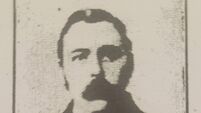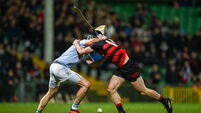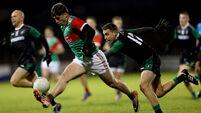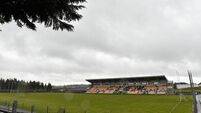John Fogarty: Hurling league change will keep teams honest

LEAGUE CHANGE; Limerick captain Cian Lynch lifts the cup after the Allianz Hurling League Final. Photo by Eóin Noonan/Sportsfile
There was a time, not so fadó, that the Allianz Hurling League mattered.
A whole pile, actually. Enough for a county to use all of its considerable diplomatic heft to try and convince the powers-that-be at the time to annul their relegation by introducing a new structure (Cork, 2013). They did not succeed.
Enough for another to canvass against a reformat voiding of their promotion from Division 2 to 1 (Limerick, 2011).
“We earned the right to be in Division One and it’s in Division 1 where we should be,” said the county’s then chairman Liam Lenihan.
Enough to convince a joint manager to resign after the county board claimed he apologised to board officials for the team’s “abysmal displays” in that year’s campaign (Limerick, 2014).
Donal O’Grady was so offended by the assertion that he had said sorry for the performances (really, it came down to the draw against Offaly) that he felt he had no choice but to leave.
“It's the job of team management to protect the players at all times,” he explained. “We were set down as having apologised. If you're apologising, it implies that you're agreeing that they (the players) served up abysmal displays. We said all along that we took full responsibility for the way the team played.
“We wanted to get that message out there as quickly as possible. We didn't want the confidence in the camp to be undermined. It was the board officers who suggested that they put out a statement retracting that we had apologised.
"We left the meeting feeling that was the end of it. The last thing that we wanted was to drag this thing out but as the weeks went on the goalposts seemed to be shifting.”
It's ironic that Limerick’s indifferent attitude to the league is partly why the Central Competitions Control Committee (CCCC) have moved like they have to list options including seven-team divisions where two teams will be promoted and demoted each year.
When we say indifferent, inconsistent might be a better choice of world. After all, Limerick won this past season’s league as they did in 2019 and ’20. Nobody’s done it better over these past five years but it was their performances in the 2021 and ’22 competitions that gave the greatest cause for concern they simply didn’t care and thus the league was devalued.
John Kiely certainly agrees that the currency of hurling’s second biggest competition has been undermined but not by Limerick. Since 2018, the Division 1 groups have preceded two similarly-sized leagues in the form of the Munster and Leinster championships where failure is fatal.
Should the seven-team shape get the go-ahead this weekend, there will be risks for under-performing next season. Finish fourth like they did in Division 1, Group A in 2021 and ’22 and Limerick will have to sing for their supper next year in the form of a play-off to be a top flight team in 2025. The top three teams in each Division 1 group will qualify along with the play-off winners.
Much like this past season, enough water has passed under the bridge between Limerick winning the All-Ireland and beginning their defence that they are unlikely to find themselves in such a tight spot.
But did they benefit from being to take things easy in early spring? Failing to win nine of 12 league fixtures between 2021 and ’22 certainly didn’t hurt them.
And where Limerick lead, others have followed. In 2022, Clare knew they only had to beat Offaly to stay in Division 1, Group A.
Likewise, Wexford this past season were aware all that mattered was beating Westmeath to stay where they were.
A few months before that, the county’s former chairman and CCCC chief Derek Kent had indicated it was “time to revamp the leagues. They’re not competitive enough, we’re probably not taking them serious enough.”
That won’t be a problem if from 2025 there is the risk of two teams being relegated from the elite seven.
As Cork manager Pat Ryan said last month, ”If you’re in that second division (Division 1B), it’s probably harder to prepare for what you might be facing in Munster but our idea is that we will be in that top three next year and get into the top seven.”
Like all great teams, the rules are changed to refract their actions, an equalisation of sorts. The alteration to the kick-out rule in 2017 and insist the ball pass the 20-metre line was precipitated by Stephen Cluxton’s penchant for short restarts.
The forthcoming motion from the playing rules committee to direct players who take their helmets off to the sideline for treatment may also be interpreted as one prompted by the All-Ireland champions namely goalkeeper Nickie Quaid.
It's not overly difficult for Limerick to believe everyone is out to get them but in a contracting inter-county season if their approach to previous league campaigns helps to keep everyone honest they will have done hurling yet another service.
This newspaper’s story on Friday night about Donegal’s plans for a “privacy fence” around their main training pitch in Convoy received quite the reaction.
Nobody should be surprised by it given Jim McGuinness’ determination to keep things, as LA Confidential’s eager scribbler Sid Hudgens would say, off the record, on the qt and very hush-hush.
McGuinness’ involvement with teams from Down’s footballers to Waterford’s hurlers in recent years has been agreed on the strictest instructions nobody talks about it. Hence why when photos of his training session with Galway’s footballers a few years back was leaked, the team’s manager and McGuinness’ old Tralee IT buddy Pádraic Joyce expressed disappointment.
“We can’t legislate for a man that’s living in a house behind a pitch recording stuff,” said Joyce. “It’s unfair on the players that it got out. You’re invading people’s privacy at times doing that but unfortunately that’s the social media platform, the social media world we live in.” Even if it is only an ambition, the pursuit of secrecy is the name of the game for the inter-county manager. Nine years ago, a leading footballer informed a couple of journalists off the record that he was instructed by his manager to pick between International Rules and All-Stars. Later asked about the player, the manager claimed he was injured and couldn’t reveal the nature of it without his permission.
It was with good reason that Kilkenny locked the gates of Nowlan Park in 2011 after the five-in-a-row hysteria of the season previous had been considered a distraction. Nevertheless, it set the template for others to follow and act even more clandestine than before.
Few journalists will forget former Kerry manager Peter Keane’s “bit of injuries” reply when he was asked for more details on his unavailable footballers. Even if it’s a two-seven off suit hand they’re holding, managers feel they at least have to pretend they have something worth hiding.
Ten years after his excellent , former Dublin senior hurling manager Humphrey Kelleher has delivered another fascinating book that is sure to be an indispensable resource.
is a second labour of love for the Waterford native who has travelled the length and breadth of the county to tell the tales of some of the best known and obscure stadia.
Fermoy’s Fitzgerald Park, Nenagh’s MacDonagh Park and Listowel’s Frank Sheehy Park are among the club grounds that are afforded great detail outside of the principal county venues that all feature.
Fermoy relocated their home grounds from Barnane, which hosted several Munster championship games between 1906 and ’16, to Strawhall when the River Blackwaters burst its banks in a November flood and swept away the stand and goalposts. A story that obviously resonates in the county after the damage caused by Storm Balbet in Glanmire last month.
More amusing in Kelleher’s recounting of Ennis garage owner Thomas Shiels who was allowed to purchase land beside Cusack Park on the proviso he built a six-foot wall, which he did but then filled his side to allow people watch games from there.
Ten years ago, such a book might not have been possible, at least not embellished with the excellent drone photographs taken by Kelleher and Ballymun Kickhams’ man Eoin Kelly.












